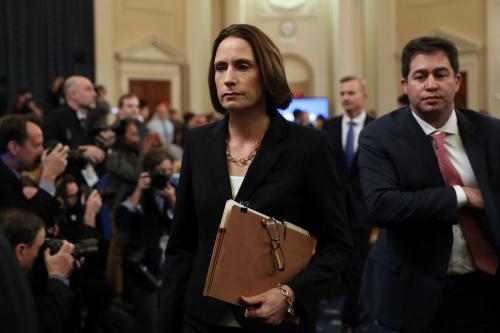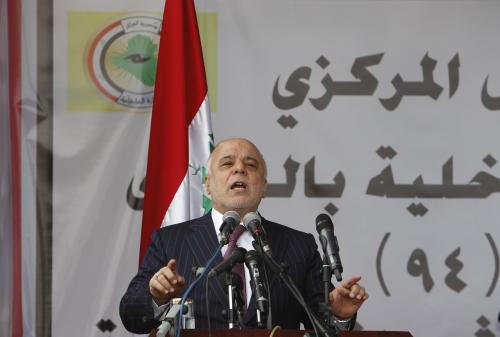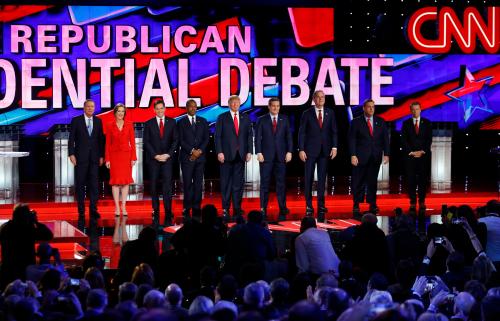India and Pakistan have fought three wars against each other since 1947, the first two of which were over Kashmir. In the past fifteen years, the two countries have been embroiled in four military crises, which the United States has played an increasingly assertive role in managing and resolving. A chief component of recent American administrations’ foreign policy goals in South Asia, including the current Bush administration, has been to avert the fourth war in the subcontinent. However, attitudes in India and Pakistan are changing, and the internal situation in Kashmir is more fluid than it has been for years. After September 11, America has been able to maintain close ties to both countries. Washington should move beyond managing the crisis and help develop a road to peace in the region.
POLICY BRIEF #109
A Three-Pronged Strategy
The cover letter President Bush submitted along with the National Security Strategy identifies its main objectives: “We will defend the peace by fighting terrorists and tyrants. We will preserve the peace by building good relations among the great powers. We will extend the peace by encouraging free and open societies on every continent.” Curiously, the Strategy is not organized around these themes, but this three-pronged approach captures the thrust of its recommendations.
Defending the Peace
The first duty of government is to provide for the common defense. This, the Bush Strategy maintains, requires defeating America’s enemies—which it identifies as a mix of terrorists, tyrants, and technology. September 11 established beyond doubt that “shadowy networks of individuals can bring great chaos and suffering to our shores.” Tyrants in a few countries have turned their states into rogues. They “brutalize their own people,” “display no regard for international law,” “are determined to acquire weapons of mass destruction,” “sponsor terrorism around the globe,” and “reject basic human values and hate the United States.” The diffusion of modern technology makes these terrorists and tyrants ever more dangerous. It could give them “a catastrophic power to strike great nations,” enabling them “to blackmail us, or to harm us, or to harm our friends.”
The Strategy’s definition of enemies does not extend to two erstwhile adversaries, Russia and China. “The events of September 11, 2001, fundamentally changed the context for relations between the United States and other main centers of global power, and opened vast new opportunities” to work with Beijing and Moscow. Even with this historic change, the United States faces a threat as grave as any in its history.” The nature and motivations of these new adversaries, their determination to obtain destructive powers hitherto available only to the world’s strongest states, and the greater likelihood that they will use weapons of mass destruction against us, make today’s security environment more complex and dangerous.”
To defeat terrorists and tyrants, the Strategy emphasizes prevention, preemption, defense, and consequence management. Prevention requires greater efforts to deny countries and terrorists access to the technologies of mass destruction, including through enhanced “diplomacy, arms control, multilateral export controls, and threat reduction assistance.” But the Strategy is silent on which arms and export control regimes it would strengthen and how it would do so.
Such preventive strategies are not enough, however. According to the Strategy, military preemption is also necessary. “Given the goals of rogue states and terrorists, the United States can no longer rely solely on a reactive posture as we have in the past. The inability to deter a potential attacker, the immediacy of today’s threats, and the magnitude of potential harm that could be caused by our adversaries” choice of weapons, do not permit that option.” Moreover, the nature of this threat means that the old standard in international law that states can legally order preemptive military action only when faced with an imminent danger of attack must be construed more broadly. The United States must have the right to “anticipatory action to defend ourselves, even if uncertainty remains as to the time and place of the enemy’s attack.”
Finally, the Strategy calls for enhanced defenses (especially missile defense), other counterproliferation measures, and effective consequence management to mitigate the effects of a chemical, biological, nuclear, or radiological weapons attack. Blunting attacks and minimizing their consequences “will help deter those who possess such weapons and dissuade those who seek to acquire them by persuading enemies that they cannot attain their desired ends.”
Preserving the Peace
Although the threat facing America has grown more grave, the Strategy sees a new opportunity to make the world safer and better. “Today the world’s great powers find ourselves on the same side—united by common dangers of terrorist violence and chaos.” The potential consequences are epoch-making. “Today,” President Bush argues, “the international community has the best chance since the rise of the nation-state in the seventeenth century to build a world where great powers compete in peace instead of continually prepare for war.”
The key to realizing this opportunity, the Strategy argues, lies in integrating Russia and China into the West. The prospects for doing so are good—in part because of the shock of September 11, which unified the great powers in opposition to terrorism, and in part because of internal developments in Russia and China.
In Russia, a new leadership now accepts what the Strategy calls the “central reality of the twenty-first century: the United States and Russia are no longer strategic adversaries.” Russia’s leaders “understand that Cold War approaches do not serve their national interests and that Russian and American strategic interests overlap in many areas.” While admitting that Moscow has an “uneven commitment to the basic values of free-market democracy,” U.S. policy needs to encourage new Russian thinking by creating opportunities for cooperation and lasting structures within which to embed it.
As for China, the Strategy departs from the confrontational tone that characterized the Bush administration’s approach early on, when U.S. officials described Beijing as a “strategic competitor.” The United States now welcomes “the emergence of a strong, peaceful, and prosperous China.” It dismisses the Chinese military buildup as “an outdated path that, in the end, will hamper its own pursuit of national greatness.” Beijing’s entry into the World Trade Organization and its rapidly changing economy will propel it onto a different, more cooperative path. “In time, China will find that social and political freedom is the only source of that greatness.” The United States can help foster this change by cooperating with China where possible, without allowing the differences that do exist (over Taiwan, human rights, and nonproliferation commitments) to interfere.
Extending the Peace
The Strategy contends that extending freedom, democracy, and free enterprise to every corner of the globe is a strategic and a moral imperative. Strategically, “the events of September 11, 2001, taught us that weak states, like Afghanistan, can pose as great a danger to our national interests as strong states. Poverty does not make poor people into terrorists and murderers. Yet poverty, weak institutions, and corruption can make weak states vulnerable to terrorist networks and drug cartels within their borders.” Morally, the poverty that grips much of the world offends American values. In short, “a world where some live in comfort and plenty, while half of the human race lives on less than $2 a day, is neither just nor stable.”
The administration proposes to enlarge the number of market democracies by pursuing an array of policies. It pledges to “speak out honestly about violations of the nonnegotiable demands of human dignity” and “make freedom and the development of democratic institutions key themes in our bilateral relations.” The United States, while being “realistic about its ability to help those who are unwilling or unready to help themselves,” will build “international relationships and institutions that can help manage local crises…[and] alleviate suffering and restore stability.” The administration will encourage the development of free markets and promote free trade to enhance prosperity for all. Finally, it will increase resources devoted to foreign aid by 50 percent over the next three years to assist “governments who rule justly, invest in their people, and encourage economic freedom.”
Evaluating the Strategy
The Bush administration’s National Security Strategy sets forth ambitious, and laudable, objectives for the United States. America should promote freedom and liberty. The threat of terrorism and rogue states must be eliminated. America should work with other great powers to pursue common interests. Poverty does present a moral and strategic challenge. What the Strategy fails to deliver, however, is a coherent and concrete guide on how to achieve these objectives.
Freedom versus Counterterrorism
The Strategy forthrightly commits to “fighting terrorists and tyrants” and “encouraging free and open societies on every continent.” What it ignores is that these two goals often conflict. In the wake of September 11, the administration successfully built a multinational coalition to wage the war on terrorism. But many of the countries in this coalition—China, Egypt, Pakistan, Saudi Arabia, and Uzbekistan, to name just a few—do not share America’s commitment to “seeking the rewards of liberty.” Which should take priority? Our commitment to our ideals? Or a concern for our safety?
The Strategy offers no advice on how to answer these questions, and it does not seem to recognize the possible contradiction. Indeed, its implicit message is that counterterrorism trumps freedom as a priority. While it speaks of creating a balance of power to further freedom, it in fact advocates a balance of power to counter terrorism. Thus, the Strategy displays none of the promised candor to “speak out honestly about violations of the nonnegotiable demands of human dignity.” It criticizes no country of consequence to the United States in the war on terrorism for specific human rights abuses—not Russia for its war on Chechnya; not China for its suppression of Tibet, democracy activists, and religious minorities; not Pakistan for its support of Kashmiri separatists or its suspension of democratic institutions. Quite the opposite—Pakistan is applauded for its “move toward building a more tolerant and open society.” The Strategy calls on Palestinians to embrace democracy, but makes no similar demand on Egypt or Saudi Arabia.
A national strategy that trumpets freedom in the abstract but subordinates it to counterterrorism in practice opens U.S. foreign policy to charges of hypocrisy. A gap between words and deeds is inevitable in any policy. But failing to have a clear plan for preventing authoritarian governments from using the war on terrorism to perpetuate their rule maximizes political costs. Many of America’s allies in the war on terrorism are democracies that must respond to their own publics. A policy that seems to say Americans will trade the freedom of others to secure their own safety hardly provides a stirring call to arms.
Even more troubling, the denial of human freedom feeds the problems of terrorism and failing states. In much of the Islamic world today, both the rulers and the ruled see the United States as buttressing authoritarianism rather than opposing it. That enables governments to avoid what the Strategy calls the “single sustainable model for national success: freedom, democracy, and free enterprise,” and breeds anti-American (and anti-Western) sentiment among their citizens. This perpetuates the nexus of poverty, failed institutions, and resentment that terrorists can manipulate to their own ends. Unless the United States closes the gap between its words and its deeds, it risks fueling the very threats that imperil its security.
Preemption versus Deterrence
Contrary to most media reports and the comments of some administration officials, the Strategy does not declare deterrence to be dead. In asserting that the United States “must build and maintain our defenses beyond challenge,” it flatly states the U.S. military must be able to “deter threats against U.S. interests, allies, and friends.” If anything, the Strategy actually broadens the role of deterrence in U.S. national security policy. The purpose of a strong military is not just to deter the adversary on the battlefield but also “to dissuade potential adversaries from pursuing a military buildup in hopes of surpassing, or equaling, the power of the United States.” Although it may be impolitic to discuss American primacy so bluntly, it is neither an unachievable nor an unreasonable goal for at least the next decade. Its practical impact may be modest, however, since most countries build up their defenses to meet immediate threats to their security, not to compete with the United States.
In contrast, the Strategy envisions a much narrower role for preemption. It discusses preemption in the specific context of defeating terrorists and rogue states. It never suggests preemption has a role to play with respect to a rising China or any residual threat posed by Russia. Nor is the argument for preempting terrorists controversial. Law enforcement, covert operations, and intelligence gathering have always sought to preempt terrorist attacks, and such preemptive activities are well-established in international law. Clinton administration officials partially justified the 1998 cruise missile attacks on targets in Afghanistan and Sudan on preventative grounds. Instead, the debate in the United States has always been about whether the U.S. government is doing enough to stop terrorists preemptively, not whether it has to wait for them to attack before acting.
The Strategy’s argument for preempting rogue states is more debatable. It rests on the disputed claim that “deterrence based upon the threat of retaliation is less likely to work against leaders of rogue states more willing to take risks.” This conclusion is based more on conjecture than hard evidence. Iraq and North Korea, the only two rogue states that the Strategy mentions by name, have both shown they understand deterrence. (Oddly, Iran, the third member of the “axis of evil,” merits no mention as a rogue state, though it fits the criteria.) Baghdad heeded warnings during the 1991 Gulf War that it faced catastrophic retaliation if it used weapons of mass destruction, and Pyongyang has abided by the armistice on the Korean peninsula for a half century and frozen its nuclear program. At the same time, the Strategy fails to acknowledge that a preemptive attack could precipitate the very attacks it seeks to prevent. An obvious danger is that the rogue state will use its weapons of mass destruction before it loses them—or deliberately give them to groups that will. A less obvious danger is that terrorists will be able to use the chaos that accompanies war to buy or steal weapons of mass destruction.
Leaving the merits of the deterrence argument aside, the Strategy provides no guidance on when to preempt. The potential target set is “a small number of rogue states,” and “the United States will not use force in all cases to preempt emerging threats.” President Bush has said that neither North Korea nor Iran is a candidate for U.S.-initiated uses of force. One danger with a preemptive strategy—that it may be employed too widely—may not apply here. Rather, talk of preemption may be a grand justification for attacking a single country, namely, Iraq. If so, it is hardly needed. The Bush administration itself has made the case for military action based on Baghdad’s defiance of numerous UN Security Council resolutions.
The Strategy’s silence on the circumstances that justify preemption raises another and more likely danger: countries will embrace the preemption argument as a cover for settling their own national security scores, as Russia has already hinted at with Georgia. As Henry Kissinger has argued, “It cannot be in either the American national interest or the world’s interest to develop principles that grant every nation an unfettered right of preemption against its own definition of threats to its security.” The Strategy recognizes this problem by warning nations not to “use preemption as a pretext for aggression.” But until the administration can define the line separating justifiable preemption from unlawful aggression in a way that gains widespread adherence abroad, it risks seeing its words used to justify ends it opposes.
Coalitions versus Institutions
To implement its national security policy, the Strategy calls for organizing “coalitions—as broad as practicable—of states able and willing to promote a balance of power that favors freedom.” The Strategy says little, however, about how the United States can best secure the cooperation of others. Instead, “coalitions of the willing” will be created as needed to address specific threats and opportunities—presumably only to dissolve once the issue at hand has been addressed. The mission creates the coalition, and not the other way around.
Previous administrations have emphasized the role that international institutions can play in helping forge international consensus. The Strategy implicitly dismisses such arrangements. It insists America “is committed to lasting institutions like the United Nations, the World Trade Organization, the Organization of American States, and NATO as well as other longstanding alliances.” But the repeated references to strengthened alliances make no mention of how this might be done, what new arrangements might be created, or what happens when allies disagree. Rather, while noting that “we will respect the values, judgment, and interests of our friends and partners,” the Strategy emphasizes that “we will be prepared to act apart when our interests and unique responsibilities require.”
This approach to coalitions rests on two dubious assumptions. The first is the presumption that coalitions sufficient to the task will form in every instance. On issues where U.S. primacy can carry the day, such as destroying rogue states, this may be true. In other areas, however, coalitions will founder as long as some remain on the outside. This is especially true when it comes to curtailing the spread of dangerous technologies. It matters little that some nations follow America’s lead in controlling such diffusion, if others do not.
The second dubious assumption is that formal institutions contribute little to American interests other than helping to achieve specified missions. History suggests otherwise. International institutions provide for regularized interactions that, over time, can turn separate national interests into shared ones. NATO, to take one example, helped knit Western Europe together during the cold war and is now extending the boundaries of the European zone of peace. By downplaying such institution building, the Strategy forfeits an opportunity to build the common interests that most of its recommendations presuppose exist among the United States and its allies and partners.
Failed States versus Promoting Prosperity
The Strategy correctly argues that failing states threaten American security. Where it comes up short is in outlining how to keep states from failing and how to rescue those that have failed.
This is not to say that the Strategy does not favor helping poor countries become prosperous. It calls on rich nations to seek “to double the size of the world’s poorest economies within a decade.” To that end, it pledges to “promote the connection between trade and development.” It also repeats President Bush’s vow to increase core U.S. development assistance by 50 percent “for projects in countries whose governments rule justly, invest in their people, and encourage economic freedom,” and to increase the amount of developmental assistance given in the form of grants instead of loans.
These initiatives are commendable. They could promote economic growth in many countries. But they will not necessarily help save failed states, whose difficulties go far deeper than a lack of capital investment. The administration’s development strategy envisions a form of tough love—states that embrace reform will be rewarded, those that do not will go without. Failing states, however, are precisely the ones least capable of ensuring the rule of law, stemming corruption, and following the sensible economic policies that the administration stipulates as conditions for help. There is the risk that the countries that need help the most will not be eligible for it, and the countries eligible for it will be the ones that need it least.



